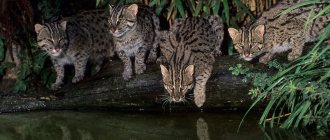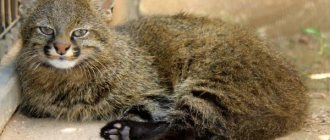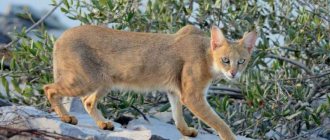What will you learn from the article?
- Origin story
- Appearance of a jungle cat
- Character
- Is it possible to keep a jungle cat at home?
- Health
- Caring for a jungle cat
- Feeding
- Where to buy a reed kitten?
Some become fans of the TV series House, while others enjoy the charm of the jungle cat, which is also called... yes, that's right - house. So, meet the jungle cat, aka house, aka swamp lynx or, scientifically, Felis chaus!
The jungle cat is a true predator that once lived in 25 countries. Nowadays, he lives only in zoos or in the apartments of his fans.
History of the breed
Felis chaus is an ancient breed that the Egyptians were the first to try to domesticate about 3 thousand years ago. Back then, hunters used the Nile cat to hunt waterfowl. Egyptian scrolls depict swimming animals that bring game to humans. In ancient times, the breed lived in at least 25 countries, but everywhere the animal had a reputation as a dangerous, wild predator, which people tried to avoid.
The beast was a serious problem for the population of the villages, as it hunted pheasants and muskrats. After the onset of cold weather, the predator moved closer to people’s houses and attacked poultry. Hunters caught wild cats to use their skins for farming. The jungle cat is not a domestic animal, but a predator living in the wild. In the 18th century, breeders were able to develop a special breed - the “house”, which is a hybrid of the reed lynx with an ordinary cat.
In the 20th century, sociable, friendly “Houseies” appeared in the United States, which were born by crossing wild jungle cats with short-haired domestic cats. This is how the Jungle Curl, Stone Cougar, and Chausi (Housey) breeds appeared, keeping them at home is safer and more legal. Breeders were able to develop breeds that retained the external beauty, large size and disposition of a wild nocturnal animal, combined with the docility of a domestic pet.
Appearance Features
Pets of this species have a dangerous temperament, and felinologists even warn against possible difficulties. But first, let's give a description of the jungle cat breed.
Weight reaches 12-15 kg. The cats are large at the withers, up to half a meter. The tail is relatively short, very thin, no more than 35 cm long. The head is not very large, rounded. The ears are large and have tufts inside.
The eyes are almond-shaped, regular in shape. The claws are very massive and sharp. The color is varied, from gray to dark brown with shades of red.
The pattern is interesting: blurry spots, stripes. The fur is quite thick and dense.
In the photo, jungle cats seem docile and very peaceful, but these beauties can literally turn a house upside down.
What does a jungle cat look like?
The resemblance of the reed cat to a lynx is reflected in the red-gray coat color, long strong legs, and the presence of small tufts on the ears. Despite these similar features, the swamp cat has a significantly smaller body size than the lynx. It is characterized by:
- height at withers up to 50 cm, body length – 60-90 cm and weight from 5 to 12 kg;
- thin, short tail (20-30 cm);
- medium-sized round head with large erect ears, an elongated muzzle (barely noticeable tassels on the ears);
- sharp, retractable claws;
- eyes with vertically elongated pupils;
- dense, thick coat (fluffier in winter, sparse and coarse in summer).
Subspecies of Houses
The color of the predator depends on its habitat. Thus, in South Asia, red-brown cats are more common; in Central Asia and on the African continent, the coat color has gray-yellow shades. Animals living in cold conditions have a furry coat that is more fluffy, thicker, and longer. House subspecies differ in color, which can be:
- gray;
- brown;
- olive;
- red;
- whitish;
- with transverse stripes;
- with small fuzzy spots
Description of the animal
House is a medium-sized cat, but much larger than any domestic cat. Its distinctive features include:
- Slender and muscular, not too long, the body of an athlete, reaching one meter together with the tail in especially large specimens.
- The tail is significantly shorter than that of most cat species (up to 30 cm).
- The paws are long, slender and muscular, ending in large pads with powerful claws.
- High-set, medium-sized ears may have small tufts.
- Like all wild cat species, the Hausa has light spots on the back surfaces of its ears - false “eyes”. It is along them that the brood, following its mother at dusk, orients itself.
- The color of the short, dense coat is ticked - from yellowish-gray to brick-brown with noticeable gray hair.
- The muzzle is large, heavy, slightly elongated, with an elongated nose ending in a convex brick-colored lobe.
- The eyes can be topaz or emerald shades, depending on the shade of the coat.
- Large individuals weigh a little more than twenty kilograms. Domesticated ones are usually smaller than their wild relatives.
- In captivity they can live more than fifteen years, wild individuals live a little less.
This strong, large and heavy animal for a domestic cat is very graceful and agile.
Where does it live?
Swamp lynx, house, jungle or Nile cat - all these are names for one representative of the cat family that lives in tugai forests and dense reeds. Representatives of the breed lead a solitary lifestyle, do not like open areas, but sometimes make forays and come to desert places with lumpy sands. However, the animal does not go far from its habitat. In winter and spring, the predator enters settlements to hunt poultry. In mountainous areas, the house does not rise above 100 m, since heat-loving cats do not like frost and snow.
Houses are attracted to the banks of ponds with lush vegetation, where they can hunt ducks and other animals. Cats make shelters in thickets of reeds or intertwined bushes. At the same time, the animal does not make holes, preferring to occupy ready-made abandoned dwellings of foxes or badgers. Marsh lynxes do not stay in one place for a long time, periodically changing shelters. Cats often approach the coastal strip, leaving tracks on muddy areas and shallows.
Cats swim well, dive for fish, and dive into water to eliminate their own smell. The latter distinguishes the jungle cat from the domestic breed, which tends to leave odorous traces everywhere (this is how the animal marks its territory). Wild cats live in the territory:
- Kazakhstan;
- low-lying banks of the Nile and Volga;
- Indochina;
- Iran;
- Dagestan;
- Eastern Turkey;
- India;
- Palestine;
- Caucasian forests;
- river openings of Central Asia.
Population and species status
As a rule, this is a rather cautious animal, leading a secretive lifestyle, which does not allow obtaining complete and comprehensive information about the total number of these animals. Despite this, there is ample evidence that this species is on the verge of extinction in southwest and southeast Asia.
All jungle cat species are listed on CITES II, which regulates trade and protection of endangered species. In many states of India, as well as Afghanistan, it is prohibited to sell jungle cats, much less hunt them. The subspecies living on our territory is listed in the Red Book. The Caucasian subspecies is found within the territories of Ossetia, Chechnya, Ingushetia, as well as in the lower reaches of the Volga and on the Caspian coast.
Today it is known that the latest information about the Caspian jungle cats was in the 80s of the last century, although local residents claim that this predator is still found today. Since this animal has become increasingly rare in recent years, there are serious concerns that the total number has sharply decreased, and this is typical for many countries of the world. Such information indicates that such animals are on the verge of complete extinction, which cannot be allowed.
Lifestyle of the swamp lynx
The swamp lynx lives in dense lowland forests near rivers and lakes. The cat makes a shelter in the depths of reed thickets, often right on the ground, lining the rookery with wool and dry plant stems. Sometimes it spends the night in the burrows of other animals, but never digs the ground itself. The swamp lynx avoids open places, prefers to move along different paths and easily makes its way through thickets of thorny bushes. The house endures cold winters with difficulty, since it is a heat-loving animal.
The animal leads a solitary lifestyle, with the exception of the mating season: during the breeding season, the cat takes on a partner. The female and male live and take care of the growing offspring together, dividing the prey among everyone. The house hunts on an area from 45 to 180 square meters. km., depending on the region of residence. The male's territory overlaps with the habitats of several females. The reed cat is an excellent swimmer and diver, but does not like to climb trees.
- Nursing home for retirement - how to choose, living conditions and registration procedure
- How to make pizza dough
- Work from home for disabled people: vacancies
Hunting and food
The predator has excellent hearing thanks to its large ears. The cat's vision is sharp, which helps him navigate well in the dark. At the same time, the swamp lynx cannot boast of a good sense of smell and distinguishes odors much worse than other felines. The jungle cat hunts at any time of the day, but prefers to get food in the dead of night or at dusk. For prey, as a rule, it goes into impassable thickets of reeds. It looks out for the victim from ambush, slowly and quietly creeping up and attacking it with a sharp jump, then grabs it with its paws and strangles it.
The diet of wild cats is varied: the animal catches fish, small rodents, crustaceans, land and waterfowl, reptiles, and insects. During seasons characterized by low temperatures, it gets close to human settlements and steals their poultry. A jungle cat can destroy bird nests; near rodent burrows, a predator can wait in ambush for its prey for several hours in a row. The predator is not afraid of snakes, dealing with them as quickly as with frogs.
Reproduction and care of kittens
The mating season begins in February-March and can last until April. This time passes tensely, with brutal fights between rivals and loud screams. At this time, cats are especially aggressive, so it is better for humans or other animals not to come into contact with them. The conquered female accepts the courtship of the gentleman and begins to prepare for the birth of offspring. The reed lynx finds a suitable place for shelter and insulates it with its own fur.
The offspring are born in May (pregnancy lasts 2 months), and their number is always different - from 2 to 6 individuals, rarely 10 kittens are born at once. In a large litter there are fewer females than males. The kitten's weight is 60-100 g, the cubs are born blind, opening their eyes in the second week of life. The cat feeds them with milk for up to 3 months, and from two months they are gradually accustomed to regular food. The stages of growth are accelerated, while the father does not leave the family and take care of him throughout the entire period of growing up of the kittens. From 5 months they no longer need parental care.
Reproduction
The mating season for jungle cats begins at the end of winter and beginning of spring: males make their “serious” intentions known with a loud sound, thereby attracting females for mating. After this, pregnancy begins, which lasts no more than two months.
Newborn kittens grow quite quickly and soon gain their own independence.
Typically, no more than five kittens are born in one litter and, characteristically, both parents take care of them in the future. Already at the age of one month, babies turn into independent animals, they can eat and even move without assistance. By six months, they turn into skilled hunters and are finally separated from their parents.
Is it possible to keep a wild jungle cat at home?
The high price and expensive maintenance of the breed often discourages cat lovers from purchasing such a pet. If you decide to purchase an exotic predator, be sure to study the character traits of the jungle cat. If you are not willing to devote a lot of time to raising an animal, it is better not to get such a problem pet.
An adult wild cane cat will not get along in a domestic environment, no matter how hard you try to tame it. The animal will be more comfortable in a specially equipped enclosure, and the cage area should be at least 3 square meters. m, and the height is about 5 m. If the conditions of detention are ignored, the mobility of the predator will be limited and the animal will get sick. The enclosure is fenced with a metal mesh, the floor is poured with concrete, on top of which a wooden flooring is laid or sprinkled with a mixture of sand and earth. It is advisable to arrange areas with herbaceous plants in the enclosure.
The cage is equipped with a doghouse type shelter, the bottom of which is laid with straw and wooden or stone terraces. The house uses a tray with filler as a toilet. Kittens brought home at 3 months or earlier are relatively easy to tame, but require a lot of attention. It is important to understand that even the cubs of jungle cats are not harmless: the animals have a capricious character, recognize only one owner and always follow him. The pet is wary of other family members and may snort and hiss at them.
Character and behavior of the predator
The jungle cat is very active, so those who want to have a calm animal should choose a different breed. It is better to bring a kitten into the house before the age of three months. The baby will choose one owner to whom it will be devoted; the animal will remain cool towards the rest. Strangers will also not be able to establish a relationship with the pet. A special feature of the Hausa is its love of water: all jungle cats love water treatments, but they should be taught to bathe as early as possible.
When starting a Chausie, remember that the animal needs care and affection, without which the pet remembers its wild past and becomes aggressive. If you do not have the opportunity to spend a lot of time with the animal, it is better to choose another breed. Adults meow loudly in a bass voice, while kittens only snort and hiss. Houses are willful and smart, they love space and freedom. During the mating season, jungle cats can show aggression towards people and other animals.
Representatives of the breed are faithful and devoted, but they will never become tame and will not sit on your knees. Houses are not recommended for families with children. The Reed Cat gets along well with other pets, including dogs and cats, as long as they are not aggressive. Small animals and birds in the house will be at risk. Jungle cats are very dexterous, curious and smart, they easily learn to open doors, remember where things interesting to them are, and easily climb the highest furniture.
- Estrogen-rich foods
- Nordic retirement benefits for men and women
- How to make a call forward on a megaphone
Personality of the pet
Natural species of Hausa have a reserved and cautious character. These nocturnal hunters are extremely silent, changing their habits only during the mating period, which occurs at the end of winter and beginning of spring. The domesticated jungle cat, while maintaining the inherent caution of the species, is able to show curiosity and sociability, and be a playful and active pet. More often than not, House chooses one owner for himself, and his devotion is truly dog-like. But he also treats other household members with patience and kindness.
Currently, a mixture of the swamp lynx with the Abyssinian cat breed is very popular. Such animals are called Chausie. They look exactly like their wild relatives, but differ from them in their kind and affectionate character.
Chausie cat
It is worth consulting with your veterinarian about the possibility of spaying or neutering. If there are no plans to breed this type of cat, it is better to carry out such an operation, this will not only increase the life expectancy of the pet, but will also get rid of territory marks around the apartment, which will protect against unpleasant odors.
It is imperative to purchase a scratching post and a large litter tray for the animal; a regular cat litter box will not work. Also give them a bath periodically, as they love to bathe.
Features of maintenance and care
Domesticated representatives of the breed are very active, they need open space and active games. The optimal habitat for the animal is a country house. Cats love affection, walks with their owner on the street, they are adapted to relieve themselves in the tray, and do not require frequent brushing. Raising House kittens is a responsible process that requires patience, love, knowledge of the breed’s character traits and the basics of animal psychology.
The cat should be brushed daily during shedding, and once every 3-4 days after this period is over. Pets have an unstable coat change schedule: sometimes in winter there is no thick undercoat, since the living space is well heated, and summer, on the contrary, is cool, so the cat “insulates itself.” Focus on the amount of fur shed, not the season. It is better to use a brush with soft bristles. You need to bathe your pet when it gets dirty, not often. To prevent the animal from scratching the furniture, provide it with several scratching posts; they will save you from having to trim its claws.
Pros and cons of the breed
It is advisable to purchase houses for the following reasons:
- they have a rather beautiful, unusual, graceful appearance;
- strong, resilient;
- active, love to play and interact with people;
- quickly get accustomed to the potty and scratching post;
- good hunters;
- friendly, gets along with other animals;
- become attached to the owner.
The disadvantages include the following:
- pets are quite large, so they require a lot of food;
- cats need to be walked;
- because of this, they must be frequently treated for fleas and helminths;
- You can feed only high-quality food.
House cat - reed lynx with domestic habits
The breed differs from other domestic relatives in external parameters, since it has a significantly larger size than almost any other cat: the height of an adult reaches 50-75 cm, and the weight is more than 16 kg. The characteristic features of the animal’s body constitution are a relatively short body, high front legs and a not very long tail; there are small tufts on the ears, which makes the animal look like a lynx.
Despite the fact that today it is fashionable to have exotic cats, Houses are rarely found at home. This is due to the high price and characteristics of keeping a pet. Wild cats are much more difficult to get used to people, so only small kittens under 3 years of age are allowed - their socialization is more successful. It is important for captive animals to maintain an active lifestyle. The best food for the breed is lean meat, but it must also be provided with the opportunity to receive live food (hunt), otherwise its instincts will become dull, the animal will begin to get bored and get sick.
Health
Characteristic diseases
The wild ancestors rewarded the Haus with excellent health.
And if vaccinations are done on time, then cats have strong immunity and calmly react to sudden changes in temperature and humidity.
With a balanced diet, the animal always feels good and does not get sick.
Housey loves to climb as high as possible and watch what is happening in the room
Vaccinations
Only healthy cats are allowed to be vaccinated.
At the age of three months, the baby should be vaccinated against herpes virus infection, panleukopenia, and calicivirus.
After which there must be a revaccination.
Cats must be vaccinated every year; their general list should include an anti-rabies component.
Before taking the animal to the veterinarian for vaccination, it is necessary to carry out deworming.
Representatives of this breed are in dire need of affection, and owners must pay attention to the Houseie.
How to choose a kitten
It is better to buy a baby cane cat at the age of 3 months - this is the optimal age for taming and starting to train the animal. It is also at this time that the difference between a House cat and a normal kitten born in the same litter becomes apparent. At 3 months, the animal should already have all its vaccinations. When choosing a kitten, pay attention to the following aspects:
- availability of the necessary set of documents certifying the breed and pedigree of the animal;
- the kitten's disposition should be cheerful, playful, affectionate;
- the baby must be accustomed to go to the tray and use a scratching post;
- Ideally, the animal should treat other kittens and strangers well and calmly.
Where can I buy
Buying a kitten is not easy, since only a few nurseries breed and sell House cats. An alternative to finding a specialized cattery is to buy a jungle cat at an exhibition of elite breeds. It is important that the animal has all the documents and vaccinations, but even with this there is no guarantee that the pet will grow up friendly and obedient. In Russia, the breed is bred in the following institutions:
- Ascheracat (Moscow);
- Lunicorn (Moscow region);
- Benabi (Saratov).
How much does a jungle cat cost?
It is difficult to purchase a representative of the breed not only because of the small number, but also the high price. Private nurseries breed and sell kittens. In addition to them, there are companies that sell wild cats and other exotic animals. In Russia, the price of a Hausa kitten ranges from 100-150 thousand rubles. If you find a cheaper option, there is a risk that they are trying to sell you ordinary kittens of a similar color.
Gaming potential
The complex nature of this cat predetermines the system of relationships with its owners. Houses are active, tireless, and inquisitive. Keeping them requires a lot of space, and an apartment is not suitable for this: you need a plot, preferably with a pond, so that the animal can swim at any time and satisfy the need for movement. And they move a lot, including at night. The owners are considered play partners and are happy to involve them in their fun, which is very noisy and energetic. Hausas especially enjoy jumping from ambushes.
What and how to feed in captivity
The jungle cat eats once a day, and the diet consists of 200 grams of lean meat (mainly beef), 1 live rat or 2 mice). Live food can be day-old chicks or quails. You can give your cat fresh fish once a week. An important detail of the diet is fasting days, during which the predator fasts for the whole day. Your pet should be unloaded no more than once a week. Such strict measures are needed to save the animal from excess weight. To maintain your pet's health, follow these rules:
- Feed kittens up to a year 2 times a day, after a year - 1 time;
- be sure to supplement the animal’s menu with vitamins, mineral mixtures, and fresh herbs;
- do not refuse to feed plant foods or live food;
- Give your cat a fasting day once every 7-10 days.











